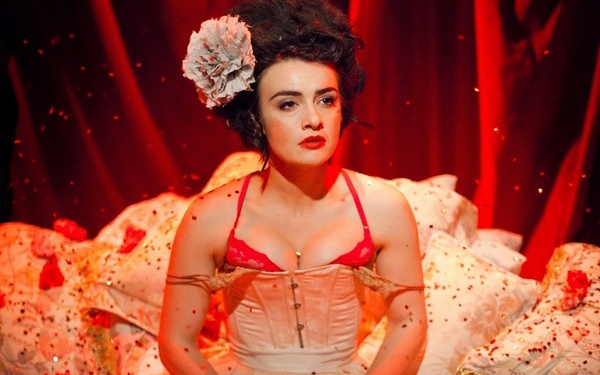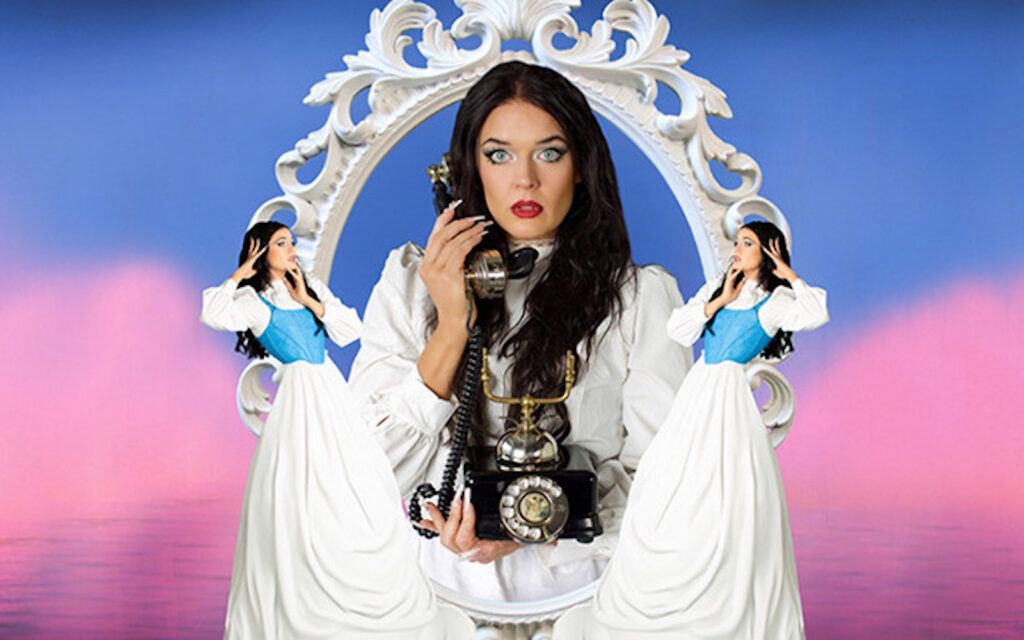“It sucks me in nice and tight,” Harbridge confides. “It’s fun.” While fun, the get-up does pose some problems. “I do have to cut long notes a bit short,” she says. “But a corset gives you so much support. I’ve heard opera singers say the same thing – that a corset lifts you around the lungs and it’s like someone is holding you. It does restrict you in a way, so you breathe deeper rather than wider.”
As a young woman, Marie Duplessis created a life for herself as a celebrity courtesan. Leaving home at just 15, she moved from Normandy to Paris on a mission to defy the regimented class system. “She came from extremely poor beginnings,” notes Harbridge. “Her real story blew my mind. She completely changed social classes with tenacity and determination; did a full-blown Pygmalian on herself by first becoming the mistress of a mid-merchant in Paris. When she was working in a dress shop; she changed her accent, her fashion sense. She was so smart – taught herself to read, learnt about world affairs and reached the point where she could walk up to anyone and engage in conversation.”
Duplessis’ reputation as a discreet, intelligent, and witty lover was well known throughout her short life. To all appearances, she was able to remain on good terms with her benefactors even after their liaisons had ended. “She seduced a lot of powerful men and left a lasting legacy,” states Harbridge. This legacy was left with some of the most powerful musical and literary giants of the day. Duplessis was the mistress of writer Alaxandre Dumas, while also acting as the mistress of composer Franz Liszt. Furthermore, she was briefly married to a French nobleman, who along with her former lover Gustav Ernst von Stackelberg was with her when she died.
Harbridge, who recently performed for the MTC in North by North West, discovered the pleasures ofmusical theatre while undertaking an acting degree at NIDA. However, cabaret has been a longtime passion. “I started doing cabaret in 2008,” she recalls. “It’s really fun dropping the fourth wall – having direct access to talk to audience.” Songs for the Fallen took her eight months to pull together, first conceiving the idea in 2012. While it’s been a long process, the performance continues to refine itself. “I revive it every year, and I develop it every season. The actors hate me,” she says. “I’m writing a new song for it now. It’s been an extraordinary experience.”
The show has been particularly well-received in New York, receiving numerous accolades and critical acclaim. The innovative score for Songs of the Fallen has been written specifically for the show. With an orchestral palette, the compositions often take inspiration from classic symphonic arrangements.
“Marie sings some big numbers,” elaborates Harbridge. “In terms of the soundtrack, I collaborated with Basil Hogios. The songs are originals. I call it baroque pop, with a harpsichord drawing room sound. It’s got a beautiful, lush classical sound.”
Working with a story told many times over, the challenge lied in reinvigorating a well worn narrative. As Harbridge states, the key to the show’s success was extensive character research in attempt to sift fact from fiction.
“There’s a lot of shadiness in what is written about her,” she says. “She did apparently have a premonition that she was going to die young, so she tried to fit it all in. She was dependent on the favours of men, she partied hard, she gave money away – she goes through it all. Her tendencies contradicted each other. She is cautious and careful for a while, and then goes mad and wild. She loses everything, comes back, loses it again, she goes through the gamut of falling in love, her whirlwind romances: she is really inspiring. She was the savviest woman in Paris to be able to change her status like that.”
Such a dramatic life naturally lends itself to creative interpretation. “Marie’s own story has such theatrical ups and downs,” says Harbridge. “Like the poet Keats, she experiences artistic flashes of ecstasy. She associated with artistic people. She was romantic and attractive to people. And she had days of fun. The structure of the show is about her pursuing the meaning of life. I wanted the show to be a party, so it’s set on her last night where she goes over her own life. She talks about how she learns the greatest thing you’ll ever learn, but that keeps changing. It flips between genres; you come to this crazy party, there’s a dance number and a food fight, and a vaudeville act between each scene. Marie never got answers, apart from to keep living life to the fullest degree.”
BY LIZA DEZFOULI







